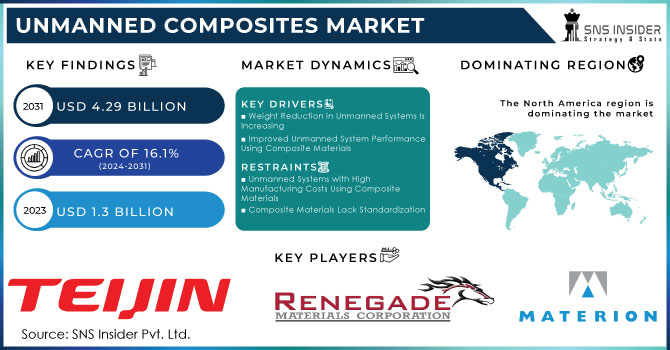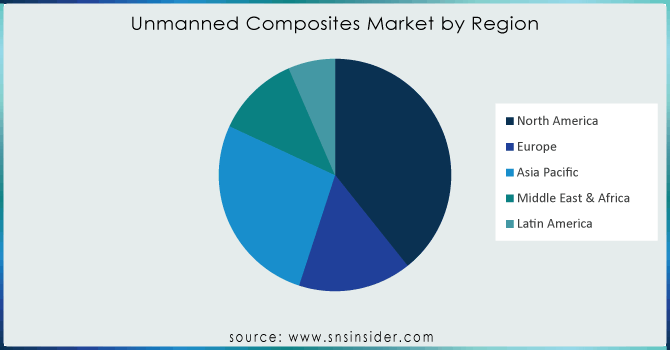Report Scope & Overview:

Get More Information on Unmanned Composites Market - Request Sample Report
Unmanned Composites Market Size was valued at USD 1.3 billion in 2023, expected to reach USD 4.29 billion by 2031, and grow at a CAGR of 16.1% over the forecast period 2024-2031.
An unmanned system is a self-piloted machine that includes all of the necessary data processing centres, sensors, automatic control systems, and communication systems. Composite materials are formed of two or more materials with differing chemical and physical properties, one of which is the reinforcing material fibre and the other is the binding substance matrix. The unmanned composites system can conduct a variety of duties, including search and rescue, military operations, citizen surveillance, and law enforcement. Unmanned composites are produced because of their superior mechanical qualities, economic effectiveness, and longevity in manufacturing and maintenance. Such qualities are provided by unmanned composite materials with no additional weight.
MARKET DYNAMICS:
KEY DRIVERS:
-
Weight Reduction in Unmanned Systems Is Increasing
-
Improved Unmanned System Performance Using Composite Materials
RESTRAINTS:
-
Unmanned Systems with High Manufacturing Costs Using Composite Materials
-
Composite Materials Lack Standardization
OPPORTUNITIES
-
Increasing Commercial Demand for Unmanned Systems
-
Increased Investment in Composite Materials by Unmanned System Manufacturers
CHALLENGES:
-
Composite materials have a high repair cost.
-
Composite Material Recyclability
THE IMPACT OF COVID-19
The COVID-19 scenario has impacted R&D in unmanned composite industries around the world due to proclaimed lockdowns and government prohibitions on public meetings.
The COVID-19 epidemic has impacted the production of composites such as aramid fibre, boron fibre, and others.
As the world returns to normalcy, there will be a significant increase in demand in the worldwide unmanned composite market in the near future.
As government investment shifts toward economic recovery as a result of the COVID-19 epidemic, companies may see a decrease in the number of orders for military UAVs, which might harm the unmanned composite market.
Following COVID-19, the unmanned composites industry is likely to increase significantly, as several countries have either ordered or are preparing to order military UAVs and other defence equipment (made of composite material) for their forces.
Carbon fibre reinforced polymer (CFRP) composites are predicted to have the greatest CAGR in the unmanned composites market throughout the forecast period. OEMs all around the world are increasing their need for lightweight, cost-effective unmanned system components. Carbon fibre is made up of carbon atoms that are aligned parallel to the main axis of the filament, which gives the structure durability and makes it easy to use in all commercial applications. These forces are propelling the CFRP segment forward.
The unmanned composites market has been divided into Unmanned Aerial Vehicle (UAV), Unmanned Ground Vehicle (UGV), Unmanned Surface Vehicle (USV), Unmanned Underwater Vehicle (UUV), Remotely Operated Vehicle (ROV), passenger drone, and autonomous ship. The UAV category is likely to dominate the market over the forecast period. UAVs, often known as drones, are frequently used in numerous military purposes. Military UAVs are in high demand for airborne surveillance, law enforcement, search and rescue, armed attacks, reconnaissance, and maritime patrol. Because these UAVs use unique composites like boron fibre and aramid fibre, the need for composites is expanding.
Interior The sector dominated the market. due to rising demand for lightweight unmanned systems, which is likely to fuel the segment's growth. Furthermore, characteristics such as high strength and efficiency given by unmanned composites are likely to enhance demand for unmanned composites for manufacturing interior components.
Exterior benefits provided by unmanned composites such as lower maintenance costs, dependability, durability, and lightweight are likely to boost growth in the global market. As a result, during the projection period, the category is expected to increase at the fastest CAGR.
UAV The market was controlled by this segment. During the forecast period, the increased usage of UAVs for military activities is likely to boost the segment's growth in the global market.
UGV During the study period, the segment would have considerable expansion in the global market, owing to factors such as rising demand for UGVs for ISR operations, detection, and monitoring USVs. The increasing use of USVs for commercial applications such as water quality monitoring and ocean data mapping is likely to boost segment growth.
AUV The category is predicted to rise at the fastest CAGR during the forecast period, owing to rising defence spending in developing nations such as China and India, as well as the increasing deployment of AUVs in the oil and gas industry.
ROV The segment is likely to expand during the forecast period as demand for improved situational awareness in naval warfare grows.
The Autonomous Ship Increased global seaborne trade and the maritime industry's expanding usage of information and communication technologies are likely to fuel the segment's growth.
Increased investment in urban air mobility solutions is likely to drive the segment's growth.
MARKET SEGMENT:
by Type
-
CFRP
-
GFRP
-
AFRP
-
BFRP
by Sub-type
-
Fiber
-
Matrix
by Application
-
Interior
-
Exterior
by Platform
-
UAV
-
USV
-
UGV
-
AUV
-
ROV
-
Passenger Drones
-
Autonomous Ships
REGIONAL ANALYSIS:
North America provides for a considerable revenue share and is likely to maintain its position during the forecast period. The presence of important firms and strong budget allocation to the military sector are elements driving growth in this region's target market. Furthermore, rising adoption of technologically advanced devices among end users, as well as strong investment in the R&D sector, are driving growth in the target market, particularly in North America's US and Canada.
The European market is likely to increase rapidly in terms of revenue in the near future. The presence of important manufacturers in nations such as the United Kingdom, Germany, Russia, and France is a crucial element driving growth in this region's target market. The Asia Pacific market is expected to grow rapidly in terms of revenue, followed by the Middle East and Africa and Latin America.

Need any customization research on Unmanned Composites Market - Enquiry Now
REGIONAL COVERAGE:
-
North America
-
USA
-
Canada
-
Mexico
-
-
Europe
-
Germany
-
UK
-
France
-
Italy
-
Spain
-
The Netherlands
-
Rest of Europe
-
-
Asia-Pacific
-
Japan
-
south Korea
-
China
-
India
-
Australia
-
Rest of Asia-Pacific
-
-
The Middle East & Africa
-
Israel
-
UAE
-
South Africa
-
Rest of Middle East & Africa
-
-
Latin America
-
Brazil
-
Argentina
-
Rest of Latin America
-
KEY PLAYERS:
Materion Corporation, Renegade Materials Corporation, TEIJIN LIMITED., Unitech Aerospace, Hexcel Corporation, TORAY INDUSTRIES INC., Stratasys Ltd., Solvay, Owens Corning, Teledyne Technologies Incorporated, and other players.
| Report Attributes | Details |
|---|---|
| Market Size in 2023 | US$ 1.3 Billion |
| Market Size by 2031 | US$ 4.29 Billion |
| CAGR | CAGR of 16.1% From 2024 to 2031 |
| Base Year | 2023 |
| Forecast Period | 2024-2031 |
| Historical Data | 2020-2022 |
| Report Scope & Coverage | Market Size, Segments Analysis, Competitive Landscape, Regional Analysis, DROC & SWOT Analysis, Forecast Outlook |
| Key Segments | • By Type (CFRP, GFRP, AFRP, BFRP) • By Sub-type (Fiber, Matrix) • By Application (Interior, Exterior) • By Platform (UAV, USV, UGV, AUV, ROV, Passenger Drones, Autonomous Ships) |
| Regional Analysis/Coverage | North America (USA, Canada, Mexico), Europe (Germany, UK, France, Italy, Spain, Netherlands, Rest of Europe), Asia-Pacific (Japan, South Korea, China, India, Australia, Rest of Asia-Pacific), The Middle East & Africa (Israel, UAE, South Africa, Rest of Middle East & Africa), Latin America (Brazil, Argentina, Rest of Latin America) |
| Company Profiles | Materion Corporation, Renegade Materials Corporation, TEIJIN LIMITED., Unitech Aerospace, Hexcel Corporation, TORAY INDUSTRIES INC., Stratasys Ltd., Solvay, Owens Corning, Teledyne Technologies Incorporated |
| KEY DRIVERS | • Weight Reduction in Unmanned Systems Is Increasing • Improved Unmanned System Performance Using Composite Materials |
| Restraints | • Unmanned Systems with High Manufacturing Costs Using Composite Materials • Composite Materials Lack Standardization |

